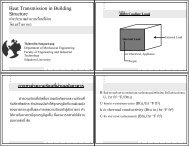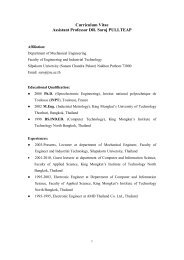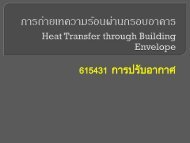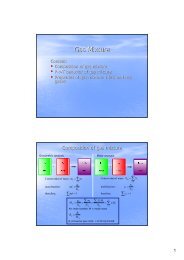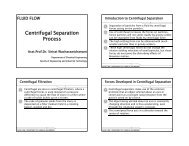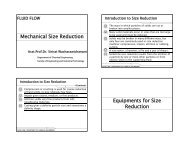Chemical Reactions
Chemical Reactions
Chemical Reactions
Create successful ePaper yourself
Turn your PDF publications into a flip-book with our unique Google optimized e-Paper software.
<strong>Chemical</strong> <strong>Reactions</strong><br />
Objectives:<br />
•Apply the conservation of mass to reacting systems to<br />
determine balanced reaction equations.<br />
•Defined the parameters used in combustion analysis, such<br />
as air-fuel ratio, percent theoretical air, and dew point<br />
temperature.<br />
•Apply energy balance to reacting systems for both steady-<br />
flow control volumes and fixed mass systems.<br />
•Calculate enthalpy of reaction, enthalpy of combustion,<br />
and the heating value of fuels.<br />
•Determine the adiabatic flame temperature for reacting<br />
mixture.<br />
Combustion of fuel Heat Heat Engine Work<br />
Combustion of fuel <strong>Chemical</strong> Reaction<br />
How much fuel is needed? How about the air used?<br />
How high the combustion flame temperature will be?<br />
Steam Generator<br />
Rocket Engine<br />
Jet Engine<br />
Piston Engine<br />
1
Fuels<br />
• Fossil Fuels: Coal, Petroleum, Natural Gases (LNG:<br />
liquid natural gas, CNG: Compressed Natural Gas)<br />
• Petroleum: Gasoline, Kerosene, Diesel, Fuel Oil ,<br />
Liquid Petroleum Gas (LPG)<br />
Fuel<br />
Approx. single Hydrocarbon<br />
Gasoline ~ Octane (C 8<br />
H 18 )<br />
Diesel<br />
~ Dodecane (C 12 H 26 )<br />
Methanol ~ Methyl Alcohol (CH 3<br />
OH)<br />
Natural gas~ Methane (CH 4<br />
)<br />
Combustion Air<br />
• Combustion is a chemical reaction during which a fuel is<br />
oxidized and a large quantity of energy is released.<br />
• Oxidizer = Oxygen<br />
• Commonly AIR is used as oxidizer (free)<br />
• By volume: AIR = 21% O 2<br />
+ 79% N 2<br />
• Therefore, 1 mole of O 2<br />
N 2<br />
= 79/21 = 3.76 mole<br />
1 kmol O 2 + 3.76 kmol N 2 = 4.76 kmol of Air<br />
Assumption at normal combustion :<br />
• N 2 absolutely inert (no reaction)<br />
• Water is also inert<br />
2
1 kmol C + 1 kmol O 2 1 kmol of CO 2<br />
C + O 2 CO 2 (15.2)<br />
Reactants<br />
Combustion<br />
Products<br />
To have combustion reaction, it must:<br />
• T > ignition temp<br />
• Fuel : air ratio must proper<br />
• To get good combustion 3T<br />
– Temperature (high)<br />
– Turbulent (good mixing between fuel and air)<br />
– Time (enough to reach complete combustion)<br />
•Balancing of chemical reaction: Conservation of mass<br />
principle<br />
• Air fuel ratio, AF = m air<br />
air /m fuel<br />
fuel (15.3)<br />
3
Example 15.1 Balancing the combustion equation<br />
One kmol of octane (C 8 H 18 ) is burned with air that<br />
contains 20 kmol of O 2 , Assuming the products<br />
contain only CO 2 , H 2 O, O 2 , and N 2 , determine the<br />
mole number of each gas in the products and the airfuel<br />
ratio for this combustion process.<br />
Solution <strong>Chemical</strong> reaction equation:<br />
C 8 H 18 +20 (O 2 + 3.76 N 2 ) xCO 2 + yH 2 O + zO 2 + wN 2<br />
Balance of each element : @ ReactantS = @ ProductS<br />
C: 8 = x x = 8<br />
H: 18 = 2y y = 9<br />
O: (20x2) = 2x +y + 2z z = 7.5<br />
N 2 : 20*3.76 = w w = 75.2<br />
Air Fuel Ratio, AF = m air /m fuel = (NM) air /(NM) fuel<br />
= 24.2 kg air/kg fuel<br />
Theoretical and Actual Combustion<br />
Processes<br />
Complete combustion: 1) all C burns to CO 2<br />
, and 2) all<br />
HC burns to H 2<br />
O<br />
Incomplete combustion: Products contains Unburned<br />
fuel or components สาเหตุหลัก: 1)Insufficient O 2<br />
2)<br />
Insufficient mixing. 3) Dissociation<br />
Stoichiometric Air or Theoretical Air:<br />
• = minimum amount of air needed for complete<br />
combustion.<br />
• no unburned and no O 2<br />
left in products<br />
• = <strong>Chemical</strong>ly correct amount of air or 100%<br />
theoretical air<br />
4
Theoretical and Actual Combustion<br />
Processes<br />
Stoichiometric Combustion or Theoretical Combustion:<br />
• Complete combustion with 100% theoretical air ; ex<br />
CH 4<br />
+ 2(O 2<br />
+ 3.76N 2<br />
) CO 2<br />
+ 2H 2<br />
O + 7.52N 2<br />
Actual combustion processes: need excess air to<br />
complete combustion<br />
% Excess air: = % more air needed than theoretical air<br />
80% excess air = 180% theoretical air<br />
Deficiency of air: = amount of air used < theoretical air<br />
(10% deficiency of air = 90% theoretical air)<br />
Theoretical and Actual Combustion<br />
Processes<br />
Equivalent Ratio = (AF actual<br />
)/(AF stoich<br />
)<br />
การประเมิน/ตรวจสอบความสมบูรณของการการเผาไหม<br />
Orsat Gas Analyzer = อุปกรณวิเคราะหองคประกอบของ combustion<br />
gas (products) ปจจุบันไมคอยนิยมใชแลว – ใช gas analyzer<br />
5
Example 15.2 dew point temperature of combustion products<br />
Ethane (C 2 H 6 ) is burned with 20% excess air during<br />
combustion process. Assuming complete combustion<br />
and a total pressure of 100 kPa, determine (a) the<br />
air fuel ratio and (b) the dew point temperature of<br />
the products.<br />
Solution<br />
(a) write the chemical reaction<br />
equation at 120% theoretical air<br />
C 2 H 6 +1.2a (O 2 + 3.76 N 2 )2CO 2 + 3H 2 O + 0.2aO 2 +(1.2x3.76)aN 2<br />
From O 2 : 1.2a = 2+ 3/2+0.2a then a = 3.5<br />
C 2 H 6 +4.2(O 2 + 3.76 N 2 ) 2CO 2 + 3H 2 O + 0.7O 2 + 15.79N 2<br />
Air Fuel Ratio, AF = m air /m fuel = (NM) air /(NM) fuel<br />
= (4.2x4.76 kmol)(29 kg/kmol)/[(2kmolx12 kg/kmol)x(3 kmol x 2 kg/kmol)]<br />
= 19.3 kg air/kg fuel<br />
C 2 H 6 +4.2(O 2 + 3.76 N 2 ) 2CO 2 + 3H 2 O + 0.7O 2 + 15.79N 2<br />
(b) T dp = T sat @ P v (H 2 O)<br />
Ideal gas mixture P i /P m = N i /N m<br />
P v = (3 kmol/21.49 kmol)(100 kPa)<br />
P v = 13.96 kPa T dp = 52.3 o C<br />
6
Example 15.3 combustion of gasous fuel with moist air<br />
A certain natural gas has the following volumetric analysis:<br />
72% CH 4 , 9% H 2 , 14%N 2 , 2%O 2 and 3%CO 2 . The gases is<br />
now burn with stochiometic amount of air that enters<br />
combustion chamber at 20 o C, 1 atm, and 80%RH. Assume<br />
complete combustion and a total pressure of 1 atm,<br />
determine the dew point temperature of the products.<br />
Solution<br />
0.72CH 4 +0.09H2+ 0.02O 2 + 0.14N 2 + 0.03CO 2<br />
ath(O 2 +3.76N 2 )+ xCO 2 + yH 2 O+zN 2<br />
Example 15.3<br />
1. write the chemical reaction equation<br />
at 100% theoretical air (use dry air)<br />
2. moles of air per kmol of fuel can be determined<br />
3. then extra moles water vapor (20%RH at inlet conditions)<br />
can be calculated<br />
4. Rewrite the chemical reaction by adding the water vapor<br />
into both side.<br />
5. N of each component in products are known<br />
6. T dp = T sat @ P v (H 2 O) (Ideal gas mixture P i /P m = N i /N m )<br />
P v = 20.88 kPa T dp = 60.9 o C<br />
7
<strong>Chemical</strong> Energy from Process<br />
This session deal with the chemical energy within the<br />
molecules of a closed system that involve a chemical<br />
reaction. During a chemical reaction, some chemical<br />
bonds that bind the atoms into molecules are broken<br />
and new ones are formed. The chemical energy<br />
associated with this process is usually different for the<br />
reactants and products.<br />
393,520 kJ<br />
1 kmol C<br />
at 25 o C, 1 atm<br />
Combustion<br />
Chamber<br />
CO 2<br />
at 25 o C, 1 atm<br />
1 kmol H<br />
at 25 o C, 1 atm<br />
241,820 kJ<br />
Combustion<br />
Chamber<br />
H 2<br />
O (g)<br />
at 25 o C, 1 atm<br />
1 kmol O 2<br />
at 25 o C, 1 atm<br />
1 kmol O 2<br />
at 25 o C, 1 atm<br />
First Law of Thermodynamics<br />
The first law of thermodynamics states that in any<br />
closed system, energy is conserved. Which means that<br />
energy cannot be created nor destroyed, but it can only<br />
change forms. Meaning:<br />
∆E sys = 0 and ∆E products =-∆E reactants<br />
The molecules of a closed system possess energy in<br />
various forms such as sensible and latent energy,<br />
chemical energy, and nuclear energy. All of these forms<br />
must balance out in the reactants and products to give<br />
the system a net energy of zero.<br />
8
Enthalpy Change<br />
Enthalpy is the system we use to measure that change<br />
in energy of a closed system due to chemical bonds<br />
being broken. Reaction enthalpies are real physical<br />
quantities for which numeric values can be calculated or<br />
measured. In order to put the calculation into algebraic<br />
form, chemists use the defined equation:<br />
∆H = Σ∆H f (products) -Σ∆H f (reactants)<br />
The reaction enthalpy, which is the enthalpy change that<br />
occurs in the reaction, is always calculated as the sum<br />
of the enthalpies of the products minus the sum of the<br />
enthalpies of the reactants.<br />
Standard Reference State<br />
Since composition of a system at the end of a process is<br />
no longer the same as that at the beginning of the<br />
process, there’s a need to use a standard condition in<br />
which to make the measurements from. This standard<br />
condition is called the standard reference point, which<br />
are 25 o C and 1 atm.<br />
The superscript “ ° ” is used to indicate property values at<br />
the standard state. The defined equation above, under<br />
standard conditions, becomes:<br />
∆H ° = Σ∆H ° f(products) -Σ∆H ° f(reactants)<br />
9
Enthalpy of Combustion<br />
The enthalpy of reaction in a combustion process is called<br />
the enthalpy of combustion (symbolized by h c ). The<br />
calculation for an enthalpy of combustion is done for 1<br />
kmol (1 kg) of fuel is burned completely at a specified<br />
temperature and pressure and can be expressed:<br />
h c =H prod –H react<br />
Example 15.5 Evaluation of the Enthalpy of Combustion<br />
Determine the enthalpy of combustion of liquid octane<br />
(C 8 H 18 ) at 25 o C and 1 atm, using enthalpy-of-formation data<br />
from table A-26. Assume the water in the products is in the<br />
liquid form.<br />
Solution<br />
1. Write chemical reaction equation<br />
based on 1 kmol of octane<br />
C 8<br />
H 18 +a(O 2<br />
+ 3.76 N 2<br />
) 8 CO 2<br />
+ 9H 2<br />
O(l) + 3.76aN 2<br />
Balance of oxygen : get a = 12.5<br />
2. Energy analysis h C = H P –H<br />
_ _ R<br />
o<br />
o<br />
H R = ∑N h f ,R = (Nh<br />
_ _ f ) C8H18<br />
_<br />
o<br />
o<br />
o<br />
H P = ∑N h f = Nh f ) + Nh f )<br />
,P<br />
(Nh CO2<br />
(Nh<br />
,P<br />
H2O<br />
10
Table A-26 A<br />
Enthalpy of Formation<br />
_<br />
o<br />
h f ,CO 2<br />
= -393,520 kJ/kmol<br />
kmol<br />
_<br />
= -285,830 kJ/kmol<br />
kmol<br />
h f<br />
o<br />
_<br />
h f<br />
o<br />
,H2O<br />
,C8H18<br />
= - 249,950 kJ/kmol<br />
kmol<br />
Enthalpy of combustion = - 5,471,100 kJ/kmol C 8 H 18<br />
= -47,891 kJ/kg C 8 H 18<br />
Disscussion: This is the HHV of liquid C 8 H 18 in Table A-27<br />
Enthalpy of formation has 2 values : 1. for vapor vapor phase 2. for liquid vapor<br />
phase -the different = laten heat of vaporization<br />
11
Enthalpy of Formation<br />
The enthalpy of formation is defined as the<br />
enthalpy of a substance at a specified state due<br />
to its chemical composition. This property makes<br />
analyzing easier because it represents chemical<br />
energy of an element or a compound at the<br />
standard reference state.<br />
The property values are obtained by first<br />
assigning all of the elements in its chemically<br />
stable form at the standard reference state a<br />
value of zero (such N2, O2, N2, C).<br />
Enthalpy of Formation<br />
So we can use this concept to find the enthalpy of<br />
formation of individual compounds by adding up the<br />
enthalpy for each reaction it takes to react some of<br />
the chemically stable elements to get the compound.<br />
•Consider the formation of CO 2 (a compound) from<br />
elements C and O 2 at 25 o C, 1 atm. during SSSF<br />
process<br />
1 st law: Q cv + ΣH i = ΣH e<br />
Q cv = H P –H R<br />
Q cv = - 393,520 kJ<br />
H R = 0 ; elements @ ref. state<br />
Enthalpy of Formation of CO 2<br />
= - 393,520 kJ/kmol<br />
12
Heating Value of Fuel<br />
= the amount of heat released when a fuel is burned completely in<br />
SSSF process and the products returned to the state of the<br />
reactants…..<br />
= absolute value of the enthalpy of combustion of the fuel:<br />
Heating value = |h C | kJ/kg fuel<br />
Higher heating value, HHV,:<br />
H 2 O in products is in LIQUID form<br />
Lower heating value, LHV,:<br />
H 2 O in products is in Vapor form<br />
HHV = LHV + (mh fg ) H2O (15.7)<br />
m = mass fo water in the products per unit mass of fuel<br />
h fg = the enthalpy of vaporization of water at the specified temp.<br />
13
15.4 First Law Analysis of Reacting System<br />
SSSF Process: (see Chapter 4 the first law) ∆KE~0,<br />
∆PE~0<br />
Q<br />
Q<br />
o<br />
cv<br />
cv<br />
(i = Reactants, and<br />
where<br />
(scrip<br />
Q<br />
cv<br />
o<br />
o<br />
+ Σ n<br />
i<br />
+ ΣN<br />
_<br />
_<br />
i<br />
_<br />
h<br />
_<br />
i<br />
h<br />
i<br />
_<br />
o<br />
f<br />
h = h<br />
_<br />
o<br />
f<br />
h = h<br />
= W<br />
o<br />
cv<br />
= W<br />
+ ( h−<br />
h<br />
e = Products)<br />
)<br />
stand for reference state which is 25 C,1atm)<br />
_<br />
Pr od<br />
cv<br />
_<br />
_<br />
+ ∆ h<br />
o<br />
+ Σ n<br />
_<br />
o<br />
e<br />
+ ΣN<br />
e<br />
Ract<br />
_<br />
T →To<br />
−Wcv<br />
= ΣNe<br />
he<br />
- ΣNi<br />
hi<br />
= H − H<br />
h ........(15-8) per rate of mole eqn.<br />
_<br />
e<br />
_<br />
h ......(15-9) per unit mole eqn.<br />
e<br />
o<br />
.........(15 -11)<br />
Closed System ∆KE~0,<br />
∆PE~0<br />
from<br />
Then<br />
or<br />
Q<br />
Q<br />
12<br />
12<br />
Q there is no u<br />
= W<br />
= W<br />
U = N{ h<br />
U = N{ h<br />
_<br />
o<br />
f<br />
12<br />
12<br />
+ ( U<br />
+ ( U<br />
U = H − PV<br />
_<br />
o<br />
f<br />
_<br />
o<br />
f<br />
Prod<br />
+ ( h−<br />
h<br />
_<br />
2<br />
_<br />
−U<br />
_<br />
o<br />
+ ( h−<br />
h<br />
_<br />
o<br />
)} − PV<br />
Provided in tables<br />
1<br />
)<br />
−U<br />
React<br />
_<br />
)........(15.....)<br />
) − P v}...........(15....)<br />
14
Example 15.6 First Law Analysis of Steady-Flow Combustion<br />
Liquid propane (C 3 H 8 ) enters a combustion chamber at 25 o C<br />
at a rate of 0.05 kg/min where it is mixed and burned with<br />
50% excess air that enters the combustion chamber at 7 o C,<br />
as shown in the figure. An analysis of the combustion gases<br />
reveals that all the hydrogen in the fuel burns to H 2 O but<br />
only 90% of carbon burns to CO 2 , with the remaining 10%<br />
forming CO. If the exit temperature of the combustion<br />
gases is 1,500 K, determine (a) the mass flow rate of the air<br />
and (b) the rate of heat transfer from the combustion<br />
chamber.<br />
Solution: Concepts<br />
1. Write chemical reaction equation based on 1 kmol of propane<br />
1.1 Theoretical Air-Fuel ratio (Stochiometic)<br />
1.2 with 150% theoretical air<br />
+ incomplete burned CO AF mass flow rate of air<br />
2. Energy balance: SSSF Q = H P –H R<br />
- Stochiometic combustion equation based on 1 kmol of propane<br />
C 3<br />
H (l)+a(O 8 2<br />
+ 3.76 N 2<br />
) 3CO 2<br />
+ 4H 2<br />
O + 3.76aN 2<br />
Balance of oxygen : get a = 5<br />
- 150% theoretical air combustion equation based on 1 kmol of propane<br />
with 90%CCO 2 + 10%CCO<br />
C 3<br />
H (l)+(1.2*5)(O<br />
8 2 + 3.76 N 2 ) (0.9*3)CO<br />
2<br />
+ (0.1*3)CO + 2.65O 2<br />
+ 4H 2<br />
O + 28.2N 2<br />
(a) AF = m air /m fuel = (NM) air /(NM) fuel = ………………. = 25.53 kg air/kg fuel<br />
mass flow rate of air, m dot,air = m dot,fuel AF<br />
= (0.05 kg fuel/min)(25.53 kg air/kg fuel) = 1.18 kg air/min<br />
Answer<br />
15
Q<br />
(i = Reactants, and<br />
Q<br />
cv<br />
cv<br />
where<br />
2<br />
_<br />
+ ΣN<br />
h = W<br />
i<br />
_<br />
_<br />
= ΣN<br />
h − ΣN<br />
h<br />
_<br />
o<br />
f<br />
Remark : h<br />
e<br />
i<br />
e<br />
_<br />
o<br />
f<br />
cv<br />
+ ΣN<br />
i<br />
_<br />
e = Products, W<br />
_<br />
_<br />
o<br />
h = h + ( h−<br />
h ),<br />
_<br />
o<br />
f<br />
_<br />
o<br />
f<br />
( g)<br />
= h<br />
_<br />
i<br />
298K<br />
_<br />
( l)<br />
+ h<br />
e<br />
_<br />
h<br />
e<br />
_<br />
o<br />
( h<br />
cv<br />
= 0)<br />
_<br />
= h<br />
Assume air and combustion gases are ideal gases, get data from the property tables<br />
h<br />
h<br />
Substitute, Q cv<br />
= 363,880 kJ/kmol fuel 8,270 kJ/kg fuel Q dot<br />
= m dot<br />
Q = 6.89 kW<br />
_<br />
280K<br />
_<br />
298K<br />
1500K<br />
Substance (kJ/kmol) (kJ/kmol) (kJ/kmol) (kJ/kmol)<br />
C3H8(<br />
l)<br />
-118,910 0 NA NA<br />
O2<br />
0 8,682 8,150 49,292<br />
N2<br />
0 8,669 8,141 47,073<br />
H 2O(<br />
g)<br />
- 241,820 9,904 NA 57,999<br />
CO -393,520 9,364 NA 71,078<br />
CO -110,530 8,669 NA 47,517<br />
fg<br />
h<br />
h<br />
)<br />
Example 15.7 First Law Analysis of Combustion in a Bomb<br />
Constant volume tank contains 1 kmol of methane (CH 4 ) gas<br />
and 3 kmol of O 2 at 25 o C and 1 atm. The contents of the<br />
tank are ignited, and the methane gas burns completely. If<br />
the final temperature is 1,000K, determine (a) the final<br />
pressure in the tank and (b) the heat transfer during this<br />
process.<br />
Solution: Concepts<br />
1. Write chemical reaction equation<br />
Assume ideal gas for both reactants and<br />
products: PV = NR u T P 2<br />
2. Energy balance: SSSF<br />
Q = U P –U R<br />
= (H p -P P V) - (H R -P R V)<br />
16
(a) Combustion equation:<br />
CH 4 (g)+ 3O 2 CO 2 + 2H 2 O + O 2<br />
N react = 1 + 3 = 4 kmol, N react = 1 + 2 + 1 = 4 kmol, N 1 = N 2<br />
Assume ideal gas for all gases:<br />
State 1 (Reactants) P 1 V = N 1 R u T 1 (1)<br />
State 2 (Products) P 2 V = N 2 R u T 2 (2)<br />
eqn(2)/eqn(1) P 2 = (T 2 /T 1 )*P 1 = (1,000K/298K)(1atm) = 3.36 atm<br />
answer<br />
First law :<br />
W<br />
12<br />
from<br />
or<br />
Ideal gas P v = R T<br />
then<br />
= 0 :<br />
U = N{ h<br />
U = N{ h<br />
from property tables get valus of h f , h<br />
substitute in equation above - - ><br />
Amount of heat transfer out = - Q<br />
or = 717,590/16 =<br />
= ( U<br />
U = H − PV = N{ h<br />
_<br />
u<br />
Q<br />
Q<br />
_<br />
o<br />
f<br />
12<br />
12<br />
+ ( h−<br />
h<br />
_<br />
o<br />
f<br />
= W<br />
_<br />
_<br />
12<br />
_<br />
o<br />
+ ( h−<br />
h<br />
+ ( U<br />
_<br />
) − P v}<br />
_<br />
o<br />
44,850 kJ/kg CH<br />
+ ( h−<br />
h<br />
)<br />
Pr React<br />
odo<br />
f<br />
) − R T}<br />
_<br />
o<br />
12<br />
2<br />
−U<br />
−U<br />
_<br />
_<br />
_<br />
o<br />
)<br />
)} − PV<br />
of each gas and hat each state<br />
= 717,590 kJ/kmol CH<br />
4<br />
u<br />
1<br />
_<br />
o<br />
_<br />
Answer<br />
4<br />
17
15.5 Adiabatic Flame Temperature<br />
Adiabatic Flame Temperature = Maximum limit of combustion<br />
gas temperature of each Air – Fuel mixture<br />
(Adiabatic Flame Temperature = Combustion Temperature)<br />
Q cv =0,W cv =0 ,∆KE=,<br />
KE=∆PE=0 :<br />
1 st law<br />
_<br />
_<br />
Qcv<br />
+ ΣNi<br />
hi<br />
= Wcv<br />
+ ΣNe<br />
he<br />
ΣN<br />
R<br />
{<br />
_<br />
o<br />
h f<br />
_<br />
ΣN<br />
i<br />
_<br />
o<br />
_<br />
h<br />
+ ( h−<br />
h )}<br />
i<br />
= ΣN<br />
R<br />
e<br />
= ΣN<br />
_<br />
h<br />
P<br />
e<br />
{<br />
_<br />
o<br />
h f<br />
To Calculate the adiabatic flame temperature, T P<br />
1. Write the combustion equation<br />
2. Apply energy balance (1 st law)<br />
3. Solving by trial-and<br />
and-error technique by assume a value of T P<br />
get values…and<br />
and<br />
substitute in (2) ….LHS = RHS ..if not try new T P<br />
….. (in good procedure we can<br />
interporate the former value to get the right value of T P<br />
_<br />
_<br />
o<br />
+ ( h−<br />
h )}<br />
P<br />
• What is your first guess of T<br />
• What should be the 2 nd trial.<br />
• How about the 3 rd , 4 th ......<br />
• When/how to interporate<br />
a<br />
b<br />
<br />
Trail and error procedure<br />
LHS - RHS = Error<br />
T<br />
T 2<br />
T c<br />
Interporation<br />
T b<br />
T a<br />
c<br />
T 2<br />
E 2<br />
T a -E a<br />
T b -E b<br />
T 2<br />
0.0<br />
T c +E c<br />
T 2 = 342 o C<br />
m i =1.263 kg<br />
-E a -E b E = 0<br />
+E c<br />
Error<br />
18
Example 15.8 Adiabatic Flame Temperature in Steady Combustion<br />
Liquid octane (C 8 H 18 ) enters the combustion chamber of a<br />
gas turbine steadily at 1 atm and 25 o C, and it is burns with<br />
air that enters the combustion chamber at the same state,<br />
as shown in the figure. Determine the adiabatic flame<br />
temperature for (a) complete combustion at 100%<br />
theoretical air, (b) complete combustion at 400%<br />
theoretical air and (c) incomplete combustion (some CO in<br />
the products) with 90% theoretical air.<br />
Asumptions:<br />
1. SSSF process<br />
2. Adiabatic<br />
3. No work<br />
4. ∆KE=∆PE=0<br />
5. Air and combustion gases are ideal gas<br />
1. Combustion equation equation based on 1 kmol of octane<br />
C 8<br />
H 18<br />
+12.5(O 2<br />
+ 3.76 N 2<br />
) 8 CO 2<br />
+ 9H 2<br />
O + 47N 2<br />
at T R = 298K at T P = ?<br />
P<br />
_<br />
_<br />
Qcv<br />
+ ΣNi<br />
hi<br />
= Wcv<br />
+ ΣNe<br />
he<br />
_ _<br />
ΣNi<br />
hi<br />
= ΣNe<br />
he<br />
_ _ _<br />
_ _ _<br />
o o<br />
o o<br />
ΣN<br />
R { h f + ( h−<br />
h )} R = ΣN<br />
P { h f + ( h−<br />
h )} P<br />
_ _<br />
o<br />
Qreactants<br />
are at referencestate ( h−<br />
h ) R = 0<br />
_<br />
_ _ _<br />
o o o<br />
ΣN<br />
R { h f } R = ΣN<br />
P { h f + ( h−<br />
h )}<br />
2. Energy balance: H R = H P<br />
19
(b) 400% theoretical air : combustion equation:-.<br />
Combustion equation equation based on 1 kmol of octane<br />
C 8<br />
H 18<br />
+4.0x12.5(O 2<br />
+ 3.76 N 2<br />
) 8CO 2<br />
+ 9H 2<br />
O + (3.0x12.5)O 2<br />
+ 4.0x47N 2<br />
at T R = 298K at T P = ?<br />
by trial and error of T P<br />
Adiabatic flame temperature = 962 K ……………………..answer<br />
(C) 90% theoretical air : combustion equation:-.<br />
Combustion equation equation based on 1 kmol of octane<br />
C 8<br />
H 18<br />
+0.9x12.5(O 2<br />
+ 3.76 N 2<br />
) aCO 2<br />
+bCO + 9H 2<br />
O + 0.9x47N 2<br />
at T R = 298K at T P = ?<br />
C and O balance a = 5.5 and b = 2.5<br />
by trial and error of T P<br />
Adiabatic flame temperature = 2,236K ……………………..answer<br />
• What is your first guess of T<br />
• What should be the 2 nd trial.<br />
• How about the 3 rd , 4 th ......<br />
• When/how to interporate<br />
a<br />
b<br />
<br />
Trail and error procedure<br />
LHS - RHS = Error<br />
T<br />
T 2<br />
T c<br />
Interporation<br />
T b<br />
T a<br />
c<br />
T 2<br />
E 2<br />
T a -E a<br />
T b -E b<br />
T 2<br />
0.0<br />
T c +E c<br />
T 2 = 342 o C<br />
m i =1.263 kg<br />
-E a -E b E = 0<br />
+E c<br />
Error<br />
20
Assume air and combustion gases are ideal gases, get data from the property tables<br />
Substance (kJ/kmol) (kJ/kmol) (kJ/kmol) (kJ/kmol)<br />
C8H18(<br />
l)<br />
- 249,950 0 NA NA<br />
O2<br />
0 8,682 ............ ............<br />
N2<br />
0 8,669 ............ ............<br />
H 2O(<br />
g)<br />
- 241,820 9,904 ............ ............<br />
CO -393,520 9,364 ............ ............<br />
2<br />
CO -110,530 8,669 ............. ............<br />
Remark : h<br />
ΣN<br />
_<br />
o<br />
f<br />
( Nh<br />
)<br />
_<br />
o<br />
f<br />
_<br />
o<br />
R { h f } R<br />
C8H18<br />
_<br />
o<br />
f<br />
h<br />
_<br />
o<br />
f<br />
( g)<br />
= h<br />
P<br />
_<br />
o<br />
f<br />
= { N(<br />
h<br />
( l)<br />
+ h<br />
_<br />
o<br />
f<br />
= ΣN<br />
{ h<br />
+ ( h−<br />
h )}<br />
+ h−<br />
h )}<br />
CO2<br />
1x(<br />
−249,950)<br />
= {8( −393,520)<br />
+ h−<br />
9,364)<br />
_<br />
_<br />
h<br />
_<br />
298K<br />
_<br />
o<br />
_<br />
o<br />
+ {47(0 + h−<br />
8,669)}<br />
_<br />
_<br />
fg<br />
_<br />
_<br />
P<br />
_<br />
h<br />
+ { N(<br />
h<br />
N2<br />
xxxxK<br />
_<br />
o<br />
f<br />
CO2<br />
_<br />
_<br />
h<br />
yyyyK<br />
_<br />
o<br />
+ h−<br />
h )}<br />
H 2O<br />
+ { N(<br />
h<br />
+ h−<br />
h )}<br />
+ {9( −241,820)<br />
+ h−<br />
9,904)}<br />
_<br />
_<br />
o<br />
f<br />
_<br />
_<br />
o<br />
N2<br />
H 2O<br />
(a) Adiabatic flame temperature = 2,395 K ………………..answer<br />
21




